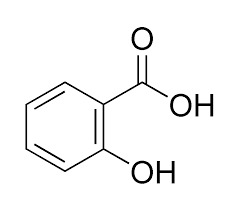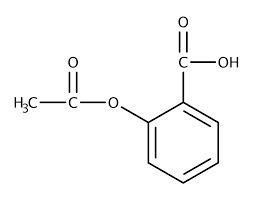
Aspirin is obtained by the reaction of acetyl chloride with
(A) Ethanol
(B) Phenol
(C) Salicylic acid
(D) Benzoic acid
Answer
559.2k+ views
Hint: We know that aspirin is also known as acetylsalicylic acid . Aspirin is a very important compound which is used to make many medicines. The molecular formula of aspirin is ${C_9}{H_8}{O_4}$. Aspirin is used as an analgesic .
Complete step by step answer:
As we know that the aspirin is formed by a special type of reaction known as esterification reaction. Acetyl chloride is a very reactive compound. Acetyl chloride reacts with Salicylic acid vigorously in the presence of pyridine to form acetylsalicylic acid or the aspirin . Pyridine is used in the reaction because the nitrogen in the pyridine is a nucleophilic catalyst. Aspirin can also be formed by the reaction of salicylic acid and acetic anhydride. So from the above explanation it is clear that aspirin is formed by the reaction of acetyl chloride and salicylic acid.

Fig:Salicylic acid

Fig: Aspirin or acetylsalicylic acid
So the correct answer of the question is : (C) Salicylic acid
Additional information:
Aspirin or acetylsalicylic acid is used to cure pain, fever and inflammation. Aspirin is a non narcotic drug. It is used as a painkiller. Aspirin is also used to cure rheumatoid arthritis, pericarditis, and Kawasaki disease. Some examples of narcotic drugs are codeine , morphine and heroin. Non narcotic drugs are offered as non prescription drugs.
Note:
Always remember that aspirin is formed by the esterification reaction. Acetyl chloride reacts with salicylic acid in the presence of pyridine to form aspirin. Aspirin is also known as acetylsalicylic acid. It is a non narcotic drug which is used to cure many diseases .
Complete step by step answer:
As we know that the aspirin is formed by a special type of reaction known as esterification reaction. Acetyl chloride is a very reactive compound. Acetyl chloride reacts with Salicylic acid vigorously in the presence of pyridine to form acetylsalicylic acid or the aspirin . Pyridine is used in the reaction because the nitrogen in the pyridine is a nucleophilic catalyst. Aspirin can also be formed by the reaction of salicylic acid and acetic anhydride. So from the above explanation it is clear that aspirin is formed by the reaction of acetyl chloride and salicylic acid.

Fig:Salicylic acid

Fig: Aspirin or acetylsalicylic acid
So the correct answer of the question is : (C) Salicylic acid
Additional information:
Aspirin or acetylsalicylic acid is used to cure pain, fever and inflammation. Aspirin is a non narcotic drug. It is used as a painkiller. Aspirin is also used to cure rheumatoid arthritis, pericarditis, and Kawasaki disease. Some examples of narcotic drugs are codeine , morphine and heroin. Non narcotic drugs are offered as non prescription drugs.
Note:
Always remember that aspirin is formed by the esterification reaction. Acetyl chloride reacts with salicylic acid in the presence of pyridine to form aspirin. Aspirin is also known as acetylsalicylic acid. It is a non narcotic drug which is used to cure many diseases .
Recently Updated Pages
Master Class 12 Business Studies: Engaging Questions & Answers for Success

Master Class 12 Social Science: Engaging Questions & Answers for Success

Master Class 12 English: Engaging Questions & Answers for Success

Master Class 12 Chemistry: Engaging Questions & Answers for Success

Class 12 Question and Answer - Your Ultimate Solutions Guide

Master Class 12 Economics: Engaging Questions & Answers for Success

Trending doubts
What are the major means of transport Explain each class 12 social science CBSE

Which are the Top 10 Largest Countries of the World?

Draw a labelled sketch of the human eye class 12 physics CBSE

How much time does it take to bleed after eating p class 12 biology CBSE

Explain sex determination in humans with line diag class 12 biology CBSE

When was the first election held in India a 194748 class 12 sst CBSE




